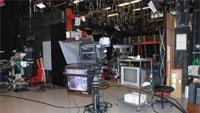Teleprompting trends
The biggest trend in today's teleprompter systems is that they must incorporate other devices. In the old days, prompter systems just delivered the script to the anchor and talent, but new demands placed on the broadcast industry require today's systems to deliver more visual information to the talent on the set.
Integration

Prompter systems now include devices like on-air monitors below the prompter itself. This enables the talent to actually see who they're interviewing or what the video is while they're doing a voice-over. Another example is placement of a SMPTE time-code clock on the prompter assembly. This allows the talent to have that information on the set as well.
In the past, some broadcasters used to jerry-rig these devices onto their prompter assemblies. Today, as broadcasters update their prompters, they're asking manufacturers to integrate these different elements into one system.
Flatter, lighter screens
One technological change that revolutionized prompting in 2000 was the development of flat-screen monitors. Today, LED screens are replacing fluorescent-based screens. LED screens deliver brighter images, with lower power consumption and increased longevity. Currently, these LED units are only suitable for smaller units, but larger units should be available by NAB2008.
The light weight of these flat prompter screens versus the old CRT monitors has made it possible to deliver larger screen studio teleprompters. In addition, it has made it possible to add on-air monitors below them, while still reducing the overall weight of the prompting assembly.
While flat-screen monitors have allowed portable, smaller teleprompters for field use, smaller screen teleprompters are at odds with another trend: The average age of broadcast talent is skewing older. The limit on the small size of a prompter has little to do with technology and more to do with the eyesight of the talent. Field prompters used to average about 12in; today they tend to be 15in. Studio teleprompters used to average 15in; now they're 17in and 20in.
Purpose-built systems
As broadcasters have come to depend more on their teleprompters both in the studio and in the field, they're also willing to buy purpose-built teleprompters instead of prompters built with off-the-shelf parts. When prompter manufacturers use off-the-shelf parts, they don't hold up for the long haul. By building from the ground up, it's possible to deliver brighter and smoother scrolling units while increasing longevity. Broadcasters have shown they're willing to pay for quality that will last.
Automation
As pressures to reduce costs increase at the stations, broadcasters are looking for new ways to improve productivity. One way to do so is to interface the prompter with newscast automation systems through the MOS protocol. This allows news-story writers to encode instructions into their scripts so that when the reading line in the teleprompter passes those instructions, it triggers the automation to make a camera move, display a graphic, or roll and take video. This enables the station to do a more sophisticated newscast with a smaller technical staff.
New scrolling capability
With the increased use of prompting in the studio, broadcasters find themselves increasing hours for teleprompter operators. Of course, no station wants to increase hours, so today manufacturers have developed multiple foot-controllers in the studio to allow the news talent to scroll their own scripts. Some systems even employ voice-recognition technology to allow the teleprompter to scroll itself by identifying exactly where the talent is in the news copy.
New teleprompters also feature wireless control so that the person scrolling the text, whether it be the news talent or a technician, isn't tethered to a specific location. For example, wireless foot-controllers quickly allow a camera in the newsroom to move its shot to the individual reporter's desk. This gives the reporter instant control of the teleprompter without running cumbersome cables.
In the field
There's also a demand to take telecasts that traditionally have been done in the studio out into the field. Recently, a major network put its evening news telecast on-location in Iraq. The prompting system, as with the rest of the technical setup, had to be able to make the anchor feel just as comfortable delivering the newscast as she would have been in the New York City studios.
Broadcasters are popping up on building tops to get shots of bombs bursting in war zones, and then ducking down to keep from being shot themselves. This puts a whole new set of criteria in play to develop a prompter that doesn't require cables and that is light enough to move quickly. Purpose-built tripod and prompter systems can eliminate the need for a separate computer, mounting plate and many of the bracket parts. They can also reduce weight significantly, allowing for use of a lighter weight fluid head and tripod.
Conclusion
Prompting has come a long way recently, from cumbersome CRT-based units to the lightweight and compact flat-screen models. Prompter assemblies have also become carriers for other devices such as on-air monitors and time displays to deliver more information to the talent. Through voice-activated prompting, the system can scroll itself. Eliminating cabling and the weight of the field prompting system has enabled broadcasters to report from new places.
Michael Accardi is president for Autoscript.
Get the TV Tech Newsletter
The professional video industry's #1 source for news, trends and product and tech information. Sign up below.













